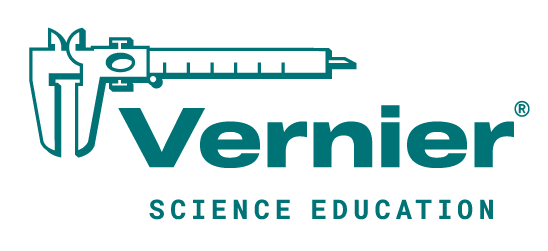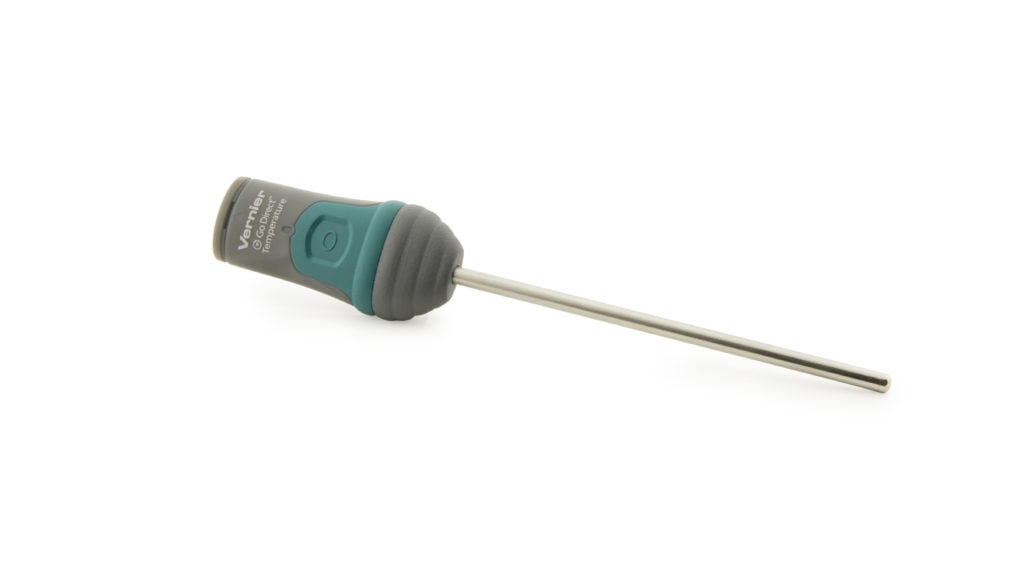Go Direct® Temperature Probe User Manual
Order Code: GDX-TMP
Go Direct Temperature can be used as a thermometer for experiments in chemistry, physics, biology, Earth science, environmental science, and more.
Note: Vernier products are designed for educational use. Our products are not designed nor are they recommended for any industrial, medical, or commercial process such as life support, patient diagnosis, control of a manufacturing process, or industrial testing of any kind.
What's Included
- Go Direct Temperature
- Micro USB Cable
Compatible Software
Choose a platform below to see its compatibility requirements.LabQuest
Interface LabQuest App LabQuest 3 Full support LabQuest 2 Full support 1 LabQuest Incompatible Compatibility Notes
Computers
Software Interface Graphical Analysis Graphical Analysis (Web App) No interface required Full support Full support LabQuest 3 Full support 1 Incompatible LabQuest 2 Full support 1 2 Incompatible Compatibility Notes
Chromebook
Software Interface Graphical Analysis (Web App) No interface required Full support iOS
Software Interface Graphical Analysis Graphical Analysis GW No interface required Full support Full support LabQuest 3 Full support 1 2 Full support 1 2 LabQuest 2 Full support 1 2 3 Full support 1 2 3 Compatibility Notes
Android
Software Interface Graphical Analysis Graphical Analysis GW No interface required Full support Incompatible LabQuest 3 Full support 1 2 Full support 1 LabQuest 2 Full support 1 2 3 Full support 1 3 Compatibility Notes
Python
Software Interface Python No interface required Full support Javascript
Software Interface Javascript No interface required Full support 1 Compatibility Notes
LabVIEW
Software Interface NI LabVIEW No interface required Full support
Quick Start: Vernier Graphical Analysis® and Bluetooth®
- Charge your sensor for at least 2 hours before first use.
- Turn on your sensor. The LED will blink red.
- Launch Graphical Analysis, then click Sensor Data Collection.
- Select your sensor from the list. The sensor ID is located on the sensor label near the bar code. Note: If you don’t see a list of available sensors, click WIRELESS. After selecting your sensor, click Pair.
- Click DONE. You are now ready to collect data.
Using other Vernier data-collection apps or want to connect via USB?
Visit www.vernier.com/start-go-direct
Note: This sensor also works with LabQuest 2 and LabQuest 3; it does not work with the original LabQuest.
Charging the Sensor
Connect Go Direct Temperature to the included Micro USB Cable and any USB device for two hours.
You can also charge up to eight Go Direct Temperature Probes using our Go Direct Charge Station, sold separately (order code: GDX-CRG). An LED on each Go Direct Temperature indicates charging status.
| Charging |
Blue LED on steady while sensor is connected to the Charging Cable or Charge Station. |
| Fully charged |
Blue LED is off when charging is complete. |
Providing Power
| Turning on the sensor |
Press button once. Red LED indicator flashes when unit is on. |
| Putting the sensor in sleep mode |
Press and hold button for more than three seconds to put into sleep mode. Red LED indicator stops flashing when sleeping. |
Connecting the Sensor
See the following link for up-to-date connection information:
Connecting via Bluetooth
| Ready to connect | Red LED flashes when sensor is awake and ready to connect via Bluetooth. |
| Connected | Green LED flashes when sensor is connected via Bluetooth. |
Connecting via USB
| Connected and charging | Blue and Green LED solid when sensor is connected to Graphical Analysis via USB and unit is charging. (Green LED is obscured by the blue one.) |
| Connected, fully charged | Green LED solid when sensor is connected to Graphical Analysis via USB and the unit is fully charged. |
| Charging via USB, connected via Bluetooth |
Blue LED is solid and green LED is flashing, but the green flashing LED looks white because it is overwhelmed by the blue. |
Identifying the Sensor
When two or more sensors are connected, the sensors can be identified by tapping or clicking Identify in Sensor Information.
Using the Product
Connect the sensor following the steps in the Quick Start section of this user manual.
- Do not put directly into flames.
- Always wash the probe thoroughly after use.
Videos
Calibrating the Sensor
Go Direct Temperature cannot be calibrated by the user. It is custom calibrated before it ships.
Specifications
|
Range |
–40 to 125°C (–40 to 257°F) |
|
Maximum temperature that the sensor can tolerate without damage |
150°C |
|
Accuracy |
±0.25°C |
|
Resolution |
0.01°C |
|
Handle range |
–10 to 45°C |
|
Response time (time for 90% of reading) |
20 seconds (in water, with stirring) |
|
USB specification |
2.0 |
|
Wireless specification |
Bluetooth 4.2 |
|
Maximum wireless range |
30 m |
|
Dimensions |
18.5 cm tall, 2 cm wide, 11.5 cm shaft length |
|
Battery |
300 mA Li-Poly |
|
Battery life (single full charge) |
~24 hours |
|
Battery life (long term) |
~500 full charge cycles (several years depending on usage) |
Care and Maintenance
Overheating the sensor is the most common cause for this sensor to break. When used in chemistry labs, students will sometimes lay the sensor on a hot plate and effectively "cook" the unit.
Unfortunately, these causes of breakage are considered misuse and are not covered by our warranty. In our experience, repair is not possible for this type of damage.
The Go Direct Temperature Probe body is constructed from grade 316 stainless steel, which provides a high level of corrosion resistance for use in the science classroom. Here are some general guidelines for usage:
- The probe handle is constructed of molded plastic. While this material is chemically resistant, we recommend that you avoid submerging the probe beyond the stainless steel part into anything but water.
- The stainless steel portion of the probe can be left continuously in water at temperatures within the range of –40 to 125°C. Continuous usage in saltwater will cause only minor discoloration of the probe, with no negative effect on performance.
- You can leave the probe continuously in most organic compounds, such as methanol, ethanol, 1-propanol, 2-propanol, 1-butanol, n-hexane, lauric acid, paradichlorobenzene, phenyl salicylate, and benzoic acid. The probe should not be left in n-pentane for more than one hour.
- The probe can be left in strong basic solutions, such as NaOH, for up to 48 hours, with only minor discoloration. We do not recommend usage in basic solutions that are greater than 3 M in concentration.
- The chart provides the maximum length of time recommended for probe exposure to some common acids. Probes left in an acid longer than these times may bubble and/or discolor, but will still be functional. We do not recommend probes be left to soak in any acid longer than 48 hours.
|
Maximum acid exposure time |
|
|---|---|
|
1 M HCl |
20 min |
|
2 M HCl |
10 min |
|
3 M HCl |
5 min |
|
1 M H2SO4 |
48 hours |
|
2 M H2SO4 |
20 min |
|
3 M H2SO4 |
10 min |
|
1 M HNO3 |
48 hours |
|
2 M HNO3 |
48 hours |
|
3 M HNO3 |
48 hours |
|
1 M CH3COOH |
48 hours |
|
2 M CH3COOH |
48 hours |
|
3 M CH3COOH |
48 hours |
|
1 M H3PO4 |
48 hours |
|
2 M H3PO4 |
48 hours |
|
3 M H3PO4 |
48 hours |
Battery Information
Go Direct Temperature contains a small lithium-ion battery in the handle. The system is designed to consume very little power and not put heavy demands on the battery. Although the battery is warranted for one year, the expected battery life should be several years. Replacement batteries are available from Vernier (order code: GDX-BAT-300).
Storage and Maintenance
To store Go Direct Temperature for extended periods of time, put the device in sleep mode by holding the button down for at least three seconds. The red LED will stop flashing to show that the unit is in sleep mode. Over several months, the battery will discharge but will not be damaged. After such storage, charge the device for a few hours, and the unit will be ready to go.
Exposing the battery to temperatures over 35°C (95°F) will reduce its lifespan. If possible, store the device in an area that is not exposed to temperature extremes.
Water Resistance
The Go Direct Temperature Probe can be submerged in water for limited periods of time. It has been tested to a depth of one meter for up to 30 minutes. However, submerging the sensor impacts the radio operation by absorbing much of the energy. This may make it difficult or impossible to connect to the sensor while submerged, particularly if there are electrically noisy signals nearby, such as pumps or motors.
Troubleshooting
For troubleshooting and FAQs, see www.vernier.com/til/3986
Repair Information
If you have watched the related product video(s), followed the troubleshooting steps, and are still having trouble with your Go Direct Temperature, contact Vernier Technical Support at support@vernier.com or call 888-837-6437. Support specialists will work with you to determine if the unit needs to be sent in for repair. At that time, a Return Merchandise Authorization (RMA) number will be issued and instructions will be communicated on how to return the unit for repair.
Accessories/Replacements
| Item | Order Code |
|---|---|
|
CB-USB-MICRO |
|
|
GDX-BAT-300 |
|
|
CB-USB-C-MICRO |
Warranty
Warranty information for this product can be found on the Support tab at www.vernier.com/gdx-tmp/#support
General warranty information can be found at www.vernier.com/warranty
Disposal
When disposing of this electronic product, do not treat it as household waste. Its disposal is subject to regulations that vary by country and region. This item should be given to an applicable collection point for the recycling of electrical and electronic equipment. By ensuring that this product is disposed of correctly, you help prevent potential negative consequences on human health or on the environment. The recycling of materials will help to conserve natural resources. For more detailed information about recycling this product, contact your local city office or your disposal service.
Battery recycling information is available at www.call2recycle.org
Do not puncture or expose the battery to excessive heat or flame.
 The symbol, shown here, indicates that this product must not be disposed of in a standard waste container.
The symbol, shown here, indicates that this product must not be disposed of in a standard waste container.
Contact Support
Fill out our online support form or call us toll-free at 1-888-837-6437.

